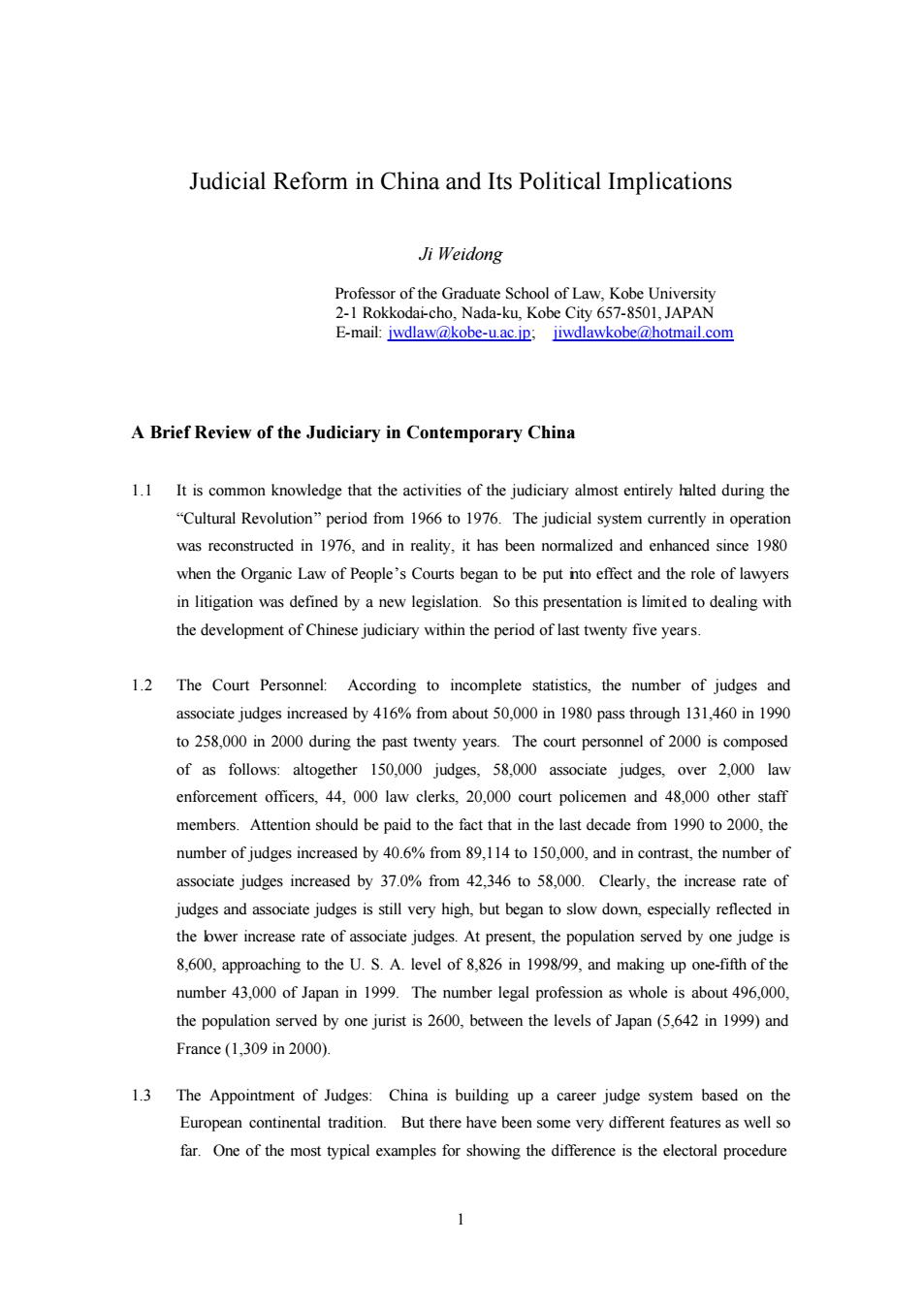
Judicial Reform in China and Its Political Implications Ji Weidong Professor of the Graduate School of Law,Kobe University 2-1 Rokkodai-cho,Nada-ku,Kobe City 657-8501,JAPAN E-mail:jwdlaw@kobe-u.ac.ip;jiwdlawkobe@hotmail.com A Brief Review of the Judiciary in Contemporary China 1.1 It is common knowledge that the activities of the judiciary almost entirely halted during the "Cultural Revolution"period from 1966 to 1976.The judicial system currently in operation was reconstructed in 1976,and in reality,it has been normalized and enhanced since 1980 when the Organic Law of People's Courts began to be put nto effect and the role of lawyers in litigation was defined by a new legislation.So this presentation is limited to dealing with the development of Chinese judiciary within the period of last twenty five years. 1.2 The Court Personnel:According to incomplete statistics,the number of judges and associate judges increased by 416%from about 50,000 in 1980 pass through 131,460 in 1990 to 258,000 in 2000 during the past twenty years.The court personnel of 2000 is composed of as follows:altogether 150,000 judges,58,000 associate judges,over 2,000 law enforcement officers,44,000 law clerks,20,000 court policemen and 48,000 other staff members.Attention should be paid to the fact that in the last decade from 1990 to 2000,the number of judges increased by 40.6%from 89,114 to 150,000,and in contrast,the number of associate judges increased by 37.0%from 42,346 to 58,000.Clearly,the increase rate of judges and associate judges is still very high,but began to slow down,especially reflected in the bwer increase rate of associate judges.At present,the population served by one judge is 8,600,approaching to the U.S.A.level of 8,826 in 1998/99,and making up one-fifth of the number 43,000 of Japan in 1999.The number legal profession as whole is about 496,000, the population served by one jurist is 2600,between the levels of Japan(5,642 in 1999)and France(1,309in2000). 1.3 The Appointment of Judges:China is building up a career judge system based on the European continental tradition.But there have been some very different features as well so far.One of the most typical examples for showing the difference is the electoral procedure 1
1 Judicial Reform in China and Its Political Implications Ji Weidong Professor of the Graduate School of Law, Kobe University 2-1 Rokkodai-cho, Nada-ku, Kobe City 657-8501, JAPAN E-mail: jwdlaw@kobe-u.ac.jp; jiwdlawkobe@hotmail.com A Brief Review of the Judiciary in Contemporary China 1.1 It is common knowledge that the activities of the judiciary almost entirely halted during the “Cultural Revolution” period from 1966 to 1976. The judicial system currently in operation was reconstructed in 1976, and in reality, it has been normalized and enhanced since 1980 when the Organic Law of People’s Courts began to be put into effect and the role of lawyers in litigation was defined by a new legislation. So this presentation is limited to dealing with the development of Chinese judiciary within the period of last twenty five years. 1.2 The Court Personnel: According to incomplete statistics, the number of judges and associate judges increased by 416% from about 50,000 in 1980 pass through 131,460 in 1990 to 258,000 in 2000 during the past twenty years. The court personnel of 2000 is composed of as follows: altogether 150,000 judges, 58,000 associate judges, over 2,000 law enforcement officers, 44, 000 law clerks, 20,000 court policemen and 48,000 other staff members. Attention should be paid to the fact that in the last decade from 1990 to 2000, the number of judges increased by 40.6% from 89,114 to 150,000, and in contrast, the number of associate judges increased by 37.0% from 42,346 to 58,000. Clearly, the increase rate of judges and associate judges is still very high, but began to slow down, especially reflected in the lower increase rate of associate judges. At present, the population served by one judge is 8,600, approaching to the U. S. A. level of 8,826 in 1998/99, and making up one-fifth of the number 43,000 of Japan in 1999. The number legal profession as whole is about 496,000, the population served by one jurist is 2600, between the levels of Japan (5,642 in 1999) and France (1,309 in 2000). 1.3 The Appointment of Judges: China is building up a career judge system based on the European continental tradition. But there have been some very different features as well so far. One of the most typical examples for showing the difference is the electoral procedure
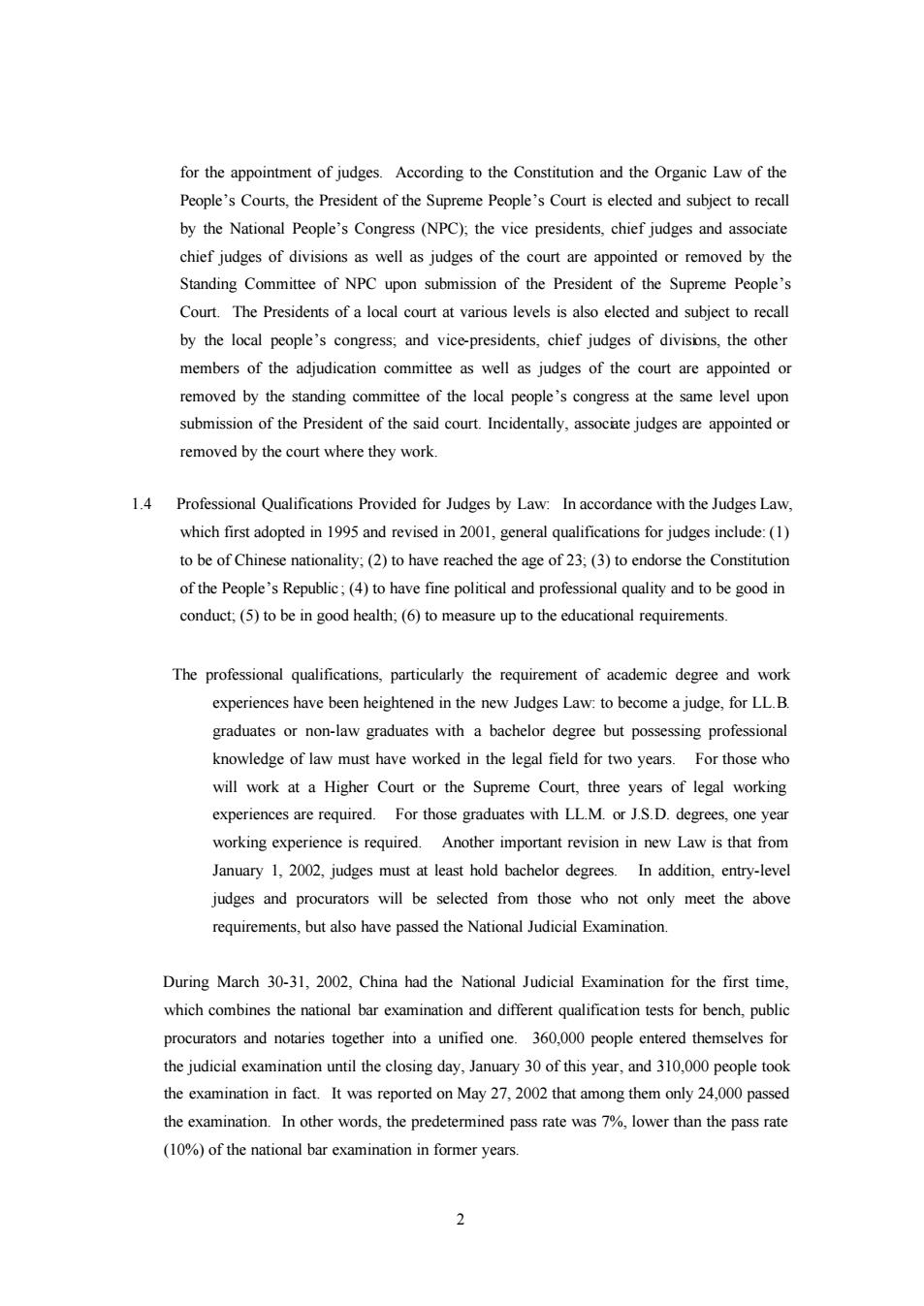
for the appointment of judges.According to the Constitution and the Organic Law of the People's Courts,the President of the Supreme People's Court is elected and subject to recall by the National People's Congress (NPC);the vice presidents,chief judges and associate chief judges of divisions as well as judges of the court are appointed or removed by the Standing Committee of NPC upon submission of the President of the Supreme People's Court.The Presidents of a local court at various levels is also elected and subject to recall by the local people's congress;and vice-presidents,chief judges of divisions,the other members of the adjudication committee as well as judges of the court are appointed or removed by the standing committee of the local people's congress at the same level upon submission of the President of the said court.Incidentally,associate judges are appointed or removed by the court where they work. 1.4 Professional Qualifications Provided for Judges by Law:In accordance with the Judges Law, which first adopted in 1995 and revised in 2001,general qualifications for judges include:(1) to be of Chinese nationality;(2)to have reached the age of 23;(3)to endorse the Constitution of the People's Republic;(4)to have fine political and professional quality and to be good in conduct;(5)to be in good health;(6)to measure up to the educational requirements. The professional qualifications,particularly the requirement of academic degree and work experiences have been heightened in the new Judges Law:to become a judge,for LL.B. graduates or non-law graduates with a bachelor degree but possessing professional knowledge of law must have worked in the legal field for two years.For those who will work at a Higher Court or the Supreme Court,three years of legal working experiences are required.For those graduates with LL.M.or J.S.D.degrees,one year working experience is required.Another important revision in new Law is that from January 1,2002,judges must at least hold bachelor degrees.In addition,entry-level judges and procurators will be selected from those who not only meet the above requirements,but also have passed the National Judicial Examination. During March 30-31,2002,China had the National Judicial Examination for the first time, which combines the national bar examination and different qualification tests for bench,public procurators and notaries together into a unified one.360,000 people entered themselves for the judicial examination until the closing day,January 30 of this year,and 310,000 people took the examination in fact.It was reported on May 27,2002 that among them only 24,000 passed the examination.In other words,the predetermined pass rate was 7%,lower than the pass rate (10%)of the national bar examination in former years. 2
2 for the appointment of judges. According to the Constitution and the Organic Law of the People’s Courts, the President of the Supreme People’s Court is elected and subject to recall by the National People’s Congress (NPC); the vice presidents, chief judges and associate chief judges of divisions as well as judges of the court are appointed or removed by the Standing Committee of NPC upon submission of the President of the Supreme People’s Court. The Presidents of a local court at various levels is also elected and subject to recall by the local people’s congress; and vice-presidents, chief judges of divisions, the other members of the adjudication committee as well as judges of the court are appointed or removed by the standing committee of the local people’s congress at the same level upon submission of the President of the said court. Incidentally, associate judges are appointed or removed by the court where they work. 1.4 Professional Qualifications Provided for Judges by Law: In accordance with the Judges Law, which first adopted in 1995 and revised in 2001, general qualifications for judges include: (1) to be of Chinese nationality; (2) to have reached the age of 23; (3) to endorse the Constitution of the People’s Republic ; (4) to have fine political and professional quality and to be good in conduct; (5) to be in good health; (6) to measure up to the educational requirements. The professional qualifications, particularly the requirement of academic degree and work experiences have been heightened in the new Judges Law: to become a judge, for LL.B. graduates or non-law graduates with a bachelor degree but possessing professional knowledge of law must have worked in the legal field for two years. For those who will work at a Higher Court or the Supreme Court, three years of legal working experiences are required. For those graduates with LL.M. or J.S.D. degrees, one year working experience is required. Another important revision in new Law is that from January 1, 2002, judges must at least hold bachelor degrees. In addition, entry-level judges and procurators will be selected from those who not only meet the above requirements, but also have passed the National Judicial Examination. During March 30-31, 2002, China had the National Judicial Examination for the first time, which combines the national bar examination and different qualification tests for bench, public procurators and notaries together into a unified one. 360,000 people entered themselves for the judicial examination until the closing day, January 30 of this year, and 310,000 people took the examination in fact. It was reported on May 27, 2002 that among them only 24,000 passed the examination. In other words, the predetermined pass rate was 7%, lower than the pass rate (10%) of the national bar examination in former years
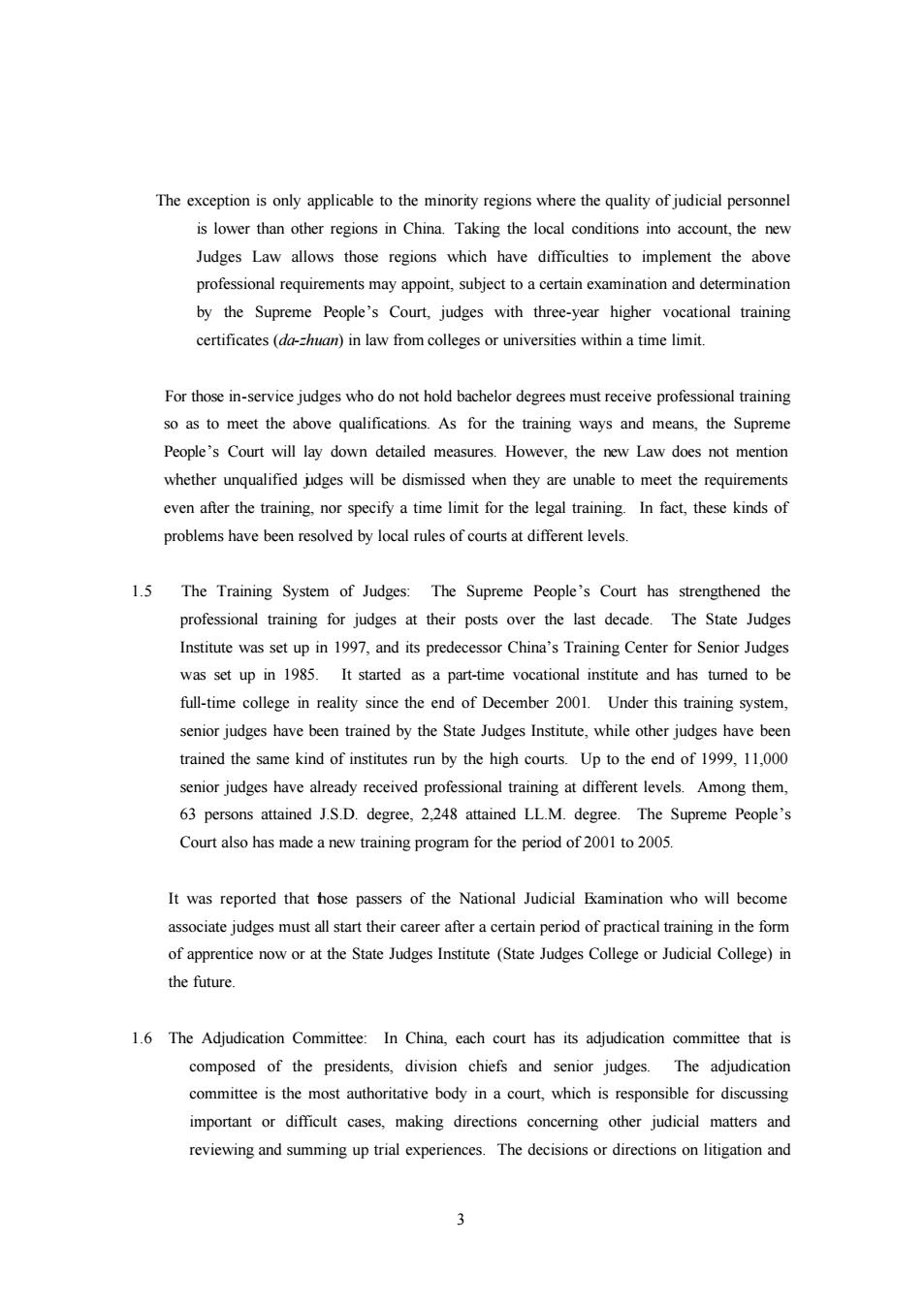
The exception is only applicable to the minority regions where the quality of judicial personnel is lower than other regions in China.Taking the local conditions into account,the new Judges Law allows those regions which have difficulties to implement the above professional requirements may appoint,subject to a certain examination and determination by the Supreme People's Court,judges with three-year higher vocational training certificates (da-zhuan)in law from colleges or universities within a time limit. For those in-service judges who do not hold bachelor degrees must receive professional training so as to meet the above qualifications.As for the training ways and means,the Supreme People's Court will lay down detailed measures.However,the new Law does not mention whether unqualified udges will be dismissed when they are unable to meet the requirements even after the training,nor specify a time limit for the legal training.In fact,these kinds of problems have been resolved by local rules of courts at different levels. 1.5 The Training System of Judges:The Supreme People's Court has strengthened the professional training for judges at their posts over the last decade.The State Judges Institute was set up in 1997,and its predecessor China's Training Center for Senior Judges was set up in 1985.It started as a part-time vocational institute and has turned to be full-time college in reality since the end of December 2001.Under this training system, senior judges have been trained by the State Judges Institute,while other judges have been trained the same kind of institutes run by the high courts.Up to the end of 1999,11,000 senior judges have already received professional training at different levels.Among them, 63 persons attained J.S.D.degree,2,248 attained LL.M.degree.The Supreme People's Court also has made a new training program for the period of 2001 to 2005. It was reported that hose passers of the National Judicial Eamination who will become associate judges must all start their career after a certain period of practical training in the form of apprentice now or at the State Judges Institute (State Judges College or Judicial College)in the future. 1.6 The Adjudication Committee:In China,each court has its adjudication committee that is composed of the presidents,division chiefs and senior judges.The adjudication committee is the most authoritative body in a court,which is responsible for discussing important or difficult cases,making directions concerning other judicial matters and reviewing and summing up trial experiences.The decisions or directions on litigation and 3
3 The exception is only applicable to the minority regions where the quality of judicial personnel is lower than other regions in China. Taking the local conditions into account, the new Judges Law allows those regions which have difficulties to implement the above professional requirements may appoint, subject to a certain examination and determination by the Supreme People’s Court, judges with three-year higher vocational training certificates (da-zhuan) in law from colleges or universities within a time limit. For those in-service judges who do not hold bachelor degrees must receive professional training so as to meet the above qualifications. As for the training ways and means, the Supreme People’s Court will lay down detailed measures. However, the new Law does not mention whether unqualified judges will be dismissed when they are unable to meet the requirements even after the training, nor specify a time limit for the legal training. In fact, these kinds of problems have been resolved by local rules of courts at different levels. 1.5 The Training System of Judges: The Supreme People’s Court has strengthened the professional training for judges at their posts over the last decade. The State Judges Institute was set up in 1997, and its predecessor China’s Training Center for Senior Judges was set up in 1985. It started as a part-time vocational institute and has turned to be full-time college in reality since the end of December 2001. Under this training system, senior judges have been trained by the State Judges Institute, while other judges have been trained the same kind of institutes run by the high courts. Up to the end of 1999, 11,000 senior judges have already received professional training at different levels. Among them, 63 persons attained J.S.D. degree, 2,248 attained LL.M. degree. The Supreme People’s Court also has made a new training program for the period of 2001 to 2005. It was reported that those passers of the National Judicial Examination who will become associate judges must all start their career after a certain period of practical training in the form of apprentice now or at the State Judges Institute (State Judges College or Judicial College) in the future. 1.6 The Adjudication Committee: In China, each court has its adjudication committee that is composed of the presidents, division chiefs and senior judges. The adjudication committee is the most authoritative body in a court, which is responsible for discussing important or difficult cases, making directions concerning other judicial matters and reviewing and summing up trial experiences. The decisions or directions on litigation and
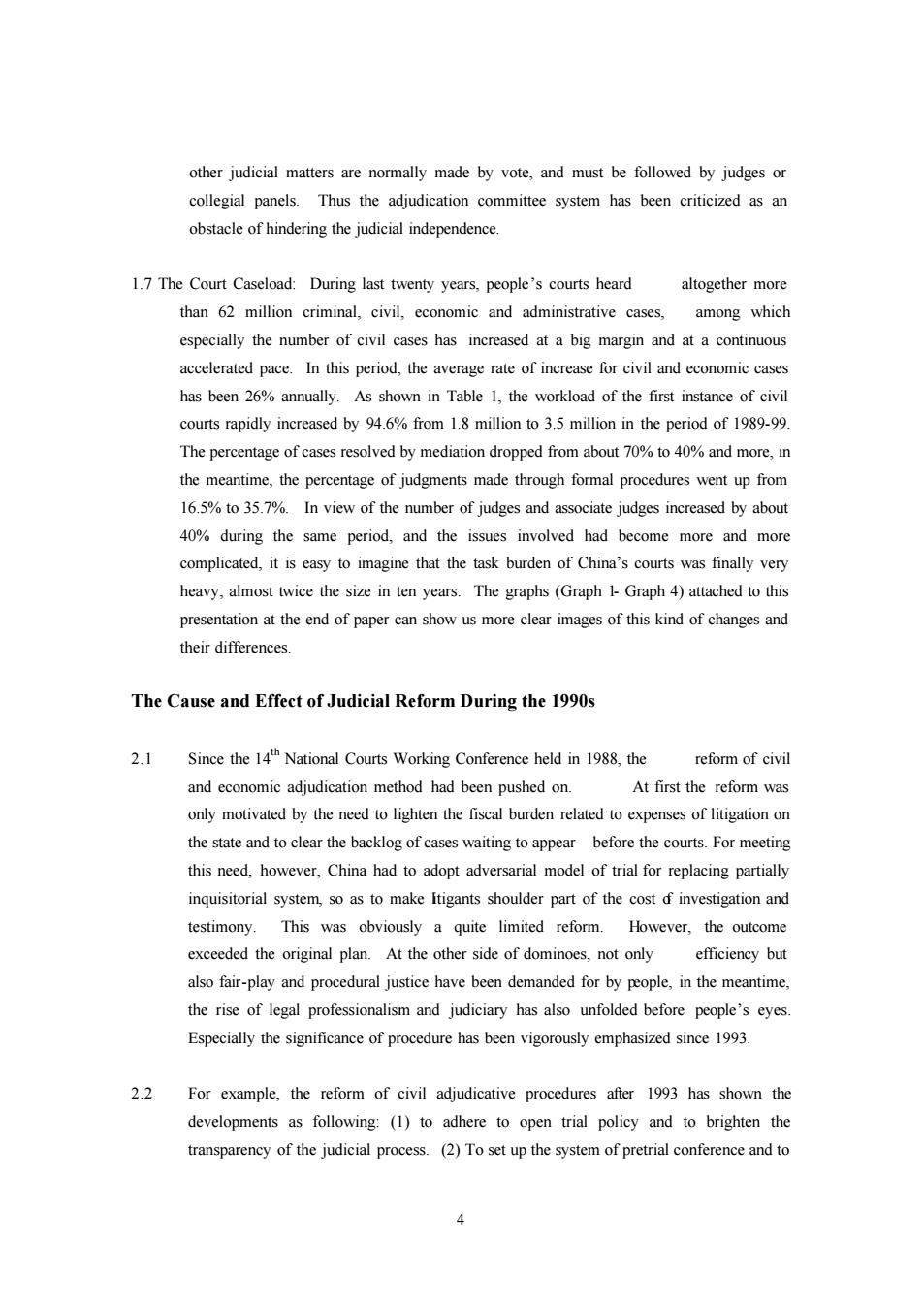
other judicial matters are normally made by vote,and must be followed by judges or collegial panels.Thus the adjudication committee system has been criticized as an obstacle of hindering the judicial independence. 1.7 The Court Caseload:During last twenty years,people's courts heard altogether more than 62 million criminal,civil,economic and administrative cases,among which especially the number of civil cases has increased at a big margin and at a continuous accelerated pace.In this period,the average rate of increase for civil and economic cases has been 26%annually.As shown in Table 1,the workload of the first instance of civil courts rapidly increased by 94.6%from 1.8 million to 3.5 million in the period of 1989-99. The percentage of cases resolved by mediation dropped from about 70%to 40%and more,in the meantime,the percentage of judgments made through formal procedures went up from 16.5%to 35.7%.In view of the number of judges and associate judges increased by about 40%during the same period,and the issues involved had become more and more complicated,it is easy to imagine that the task burden of China's courts was finally very heavy,almost twice the size in ten years.The graphs(Graph 1-Graph 4)attached to this presentation at the end of paper can show us more clear images of this kind of changes and their differences. The Cause and Effect of Judicial Reform During the 1990s 2.1 Since the 14h National Courts Working Conference held in 1988,the reform of civil and economic adjudication method had been pushed on. At first the reform was only motivated by the need to lighten the fiscal burden related to expenses of litigation on the state and to clear the backlog of cases waiting to appear before the courts.For meeting this need,however,China had to adopt adversarial model of trial for replacing partially inquisitorial system,so as to make Itigants shoulder part of the cost d investigation and testimony.This was obviously a quite limited reform.However,the outcome exceeded the original plan.At the other side of dominoes,not only efficiency but also fair-play and procedural justice have been demanded for by people,in the meantime, the rise of legal professionalism and judiciary has also unfolded before people's eyes. Especially the significance of procedure has been vigorously emphasized since 1993 2.2 For example,the reform of civil adjudicative procedures after 1993 has shown the developments as following:(1)to adhere to open trial policy and to brighten the transparency of the judicial process.(2)To set up the system of pretrial conference and to
4 other judicial matters are normally made by vote, and must be followed by judges or collegial panels. Thus the adjudication committee system has been criticized as an obstacle of hindering the judicial independence. 1.7 The Court Caseload: During last twenty years, people’s courts heard altogether more than 62 million criminal, civil, economic and administrative cases, among which especially the number of civil cases has increased at a big margin and at a continuous accelerated pace. In this period, the average rate of increase for civil and economic cases has been 26% annually. As shown in Table 1, the workload of the first instance of civil courts rapidly increased by 94.6% from 1.8 million to 3.5 million in the period of 1989-99. The percentage of cases resolved by mediation dropped from about 70% to 40% and more, in the meantime, the percentage of judgments made through formal procedures went up from 16.5% to 35.7%. In view of the number of judges and associate judges increased by about 40% during the same period, and the issues involved had become more and more complicated, it is easy to imagine that the task burden of China’s courts was finally very heavy, almost twice the size in ten years. The graphs (Graph 1- Graph 4) attached to this presentation at the end of paper can show us more clear images of this kind of changes and their differences. The Cause and Effect of Judicial Reform During the 1990s 2.1 Since the 14th National Courts Working Conference held in 1988, the reform of civil and economic adjudication method had been pushed on. At first the reform was only motivated by the need to lighten the fiscal burden related to expenses of litigation on the state and to clear the backlog of cases waiting to appear before the courts. For meeting this need, however, China had to adopt adversarial model of trial for replacing partially inquisitorial system, so as to make litigants shoulder part of the cost of investigation and testimony. This was obviously a quite limited reform. However, the outcome exceeded the original plan. At the other side of dominoes, not only efficiency but also fair-play and procedural justice have been demanded for by people, in the meantime, the rise of legal professionalism and judiciary has also unfolded before people’s eyes. Especially the significance of procedure has been vigorously emphasized since 1993. 2.2 For example, the reform of civil adjudicative procedures after 1993 has shown the developments as following: (1) to adhere to open trial policy and to brighten the transparency of the judicial process. (2) To set up the system of pretrial conference and to
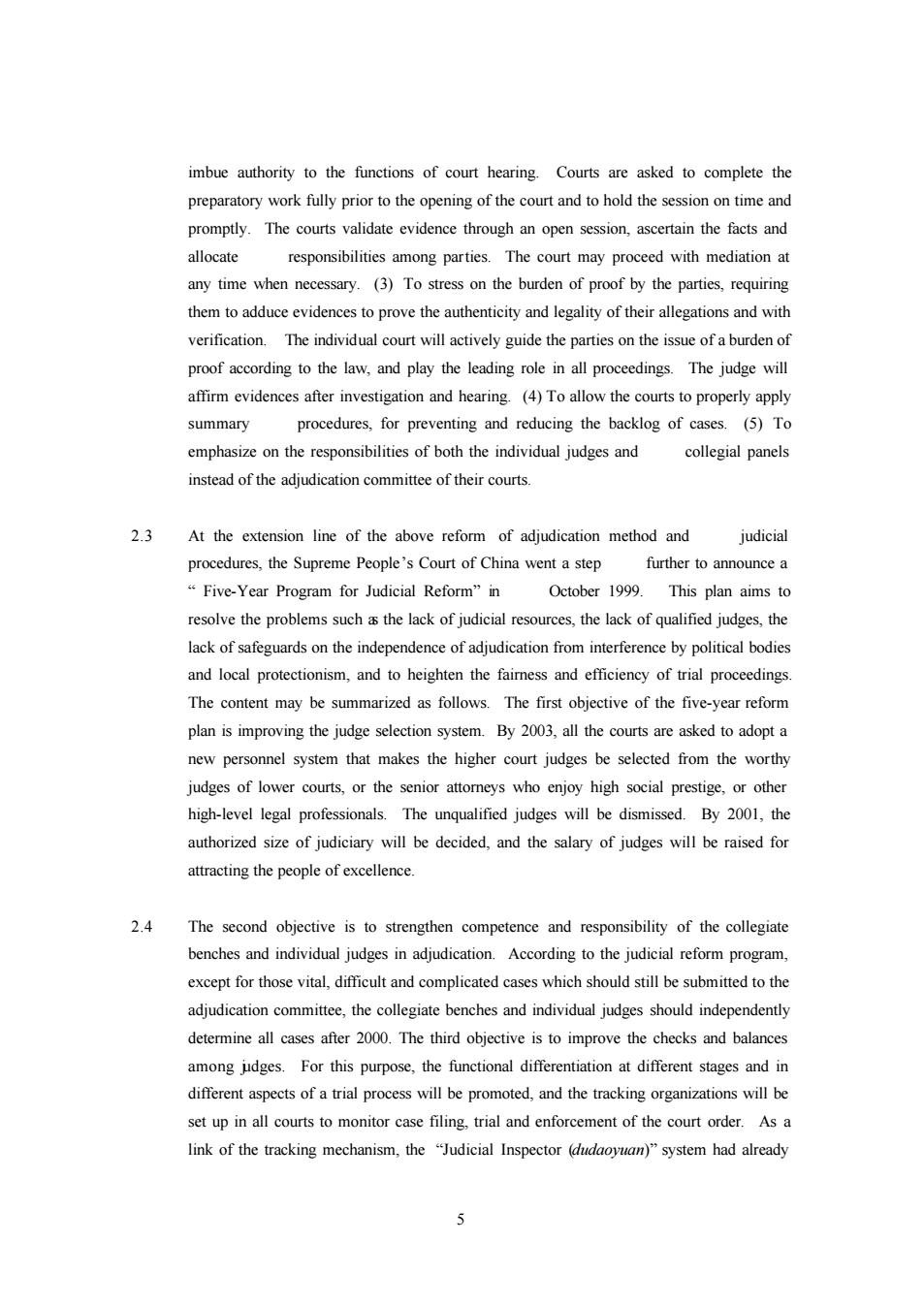
imbue authority to the functions of court hearing.Courts are asked to complete the preparatory work fully prior to the opening of the court and to hold the session on time and promptly.The courts validate evidence through an open session,ascertain the facts and allocate responsibilities among parties.The court may proceed with mediation at any time when necessary.(3)To stress on the burden of proof by the parties,requiring them to adduce evidences to prove the authenticity and legality of their allegations and with verification.The individual court will actively guide the parties on the issue of a burden of proof according to the law,and play the leading role in all proceedings.The judge will affirm evidences after investigation and hearing.(4)To allow the courts to properly apply summary procedures,for preventing and reducing the backlog of cases.(5)To emphasize on the responsibilities of both the individual judges and collegial panels instead of the adjudication committee of their courts. 2.3 At the extension line of the above reform of adjudication method and judicial procedures,the Supreme People's Court of China went a step further to announce a "Five-Year Program for Judicial Reform"in October 1999.This plan aims to resolve the problems such a the lack of judicial resources,the lack of qualified judges,the lack of safeguards on the independence of adjudication from interference by political bodies and local protectionism,and to heighten the fairness and efficiency of trial proceedings. The content may be summarized as follows.The first objective of the five-year reform plan is improving the judge selection system.By 2003,all the courts are asked to adopt a new personnel system that makes the higher court judges be selected from the worthy judges of lower courts,or the senior attorneys who enjoy high social prestige,or other high-level legal professionals.The unqualified judges will be dismissed.By 2001,the authorized size of judiciary will be decided,and the salary of judges will be raised for attracting the people of excellence. 2.4 The second objective is to strengthen competence and responsibility of the collegiate benches and individual judges in adjudication.According to the judicial reform program, except for those vital,difficult and complicated cases which should still be submitted to the adjudication committee,the collegiate benches and individual judges should independently determine all cases after 2000.The third objective is to improve the checks and balances among jdges.For this purpose,the functional differentiation at different stages and in different aspects of a trial process will be promoted,and the tracking organizations will be set up in all courts to monitor case filing,trial and enforcement of the court order.As a link of the tracking mechanism,the "Judicial Inspector (dudaoyuan)"system had already 5
5 imbue authority to the functions of court hearing. Courts are asked to complete the preparatory work fully prior to the opening of the court and to hold the session on time and promptly. The courts validate evidence through an open session, ascertain the facts and allocate responsibilities among parties. The court may proceed with mediation at any time when necessary. (3) To stress on the burden of proof by the parties, requiring them to adduce evidences to prove the authenticity and legality of their allegations and with verification. The individual court will actively guide the parties on the issue of a burden of proof according to the law, and play the leading role in all proceedings. The judge will affirm evidences after investigation and hearing. (4) To allow the courts to properly apply summary procedures, for preventing and reducing the backlog of cases. (5) To emphasize on the responsibilities of both the individual judges and collegial panels instead of the adjudication committee of their courts. 2.3 At the extension line of the above reform of adjudication method and judicial procedures, the Supreme People’s Court of China went a step further to announce a “ Five-Year Program for Judicial Reform” in October 1999. This plan aims to resolve the problems such as the lack of judicial resources, the lack of qualified judges, the lack of safeguards on the independence of adjudication from interference by political bodies and local protectionism, and to heighten the fairness and efficiency of trial proceedings. The content may be summarized as follows. The first objective of the five-year reform plan is improving the judge selection system. By 2003, all the courts are asked to adopt a new personnel system that makes the higher court judges be selected from the worthy judges of lower courts, or the senior attorneys who enjoy high social prestige, or other high-level legal professionals. The unqualified judges will be dismissed. By 2001, the authorized size of judiciary will be decided, and the salary of judges will be raised for attracting the people of excellence. 2.4 The second objective is to strengthen competence and responsibility of the collegiate benches and individual judges in adjudication. According to the judicial reform program, except for those vital, difficult and complicated cases which should still be submitted to the adjudication committee, the collegiate benches and individual judges should independently determine all cases after 2000. The third objective is to improve the checks and balances among judges. For this purpose, the functional differentiation at different stages and in different aspects of a trial process will be promoted, and the tracking organizations will be set up in all courts to monitor case filing, trial and enforcement of the court order. As a link of the tracking mechanism, the “Judicial Inspector (dudaoyuan)” system had already